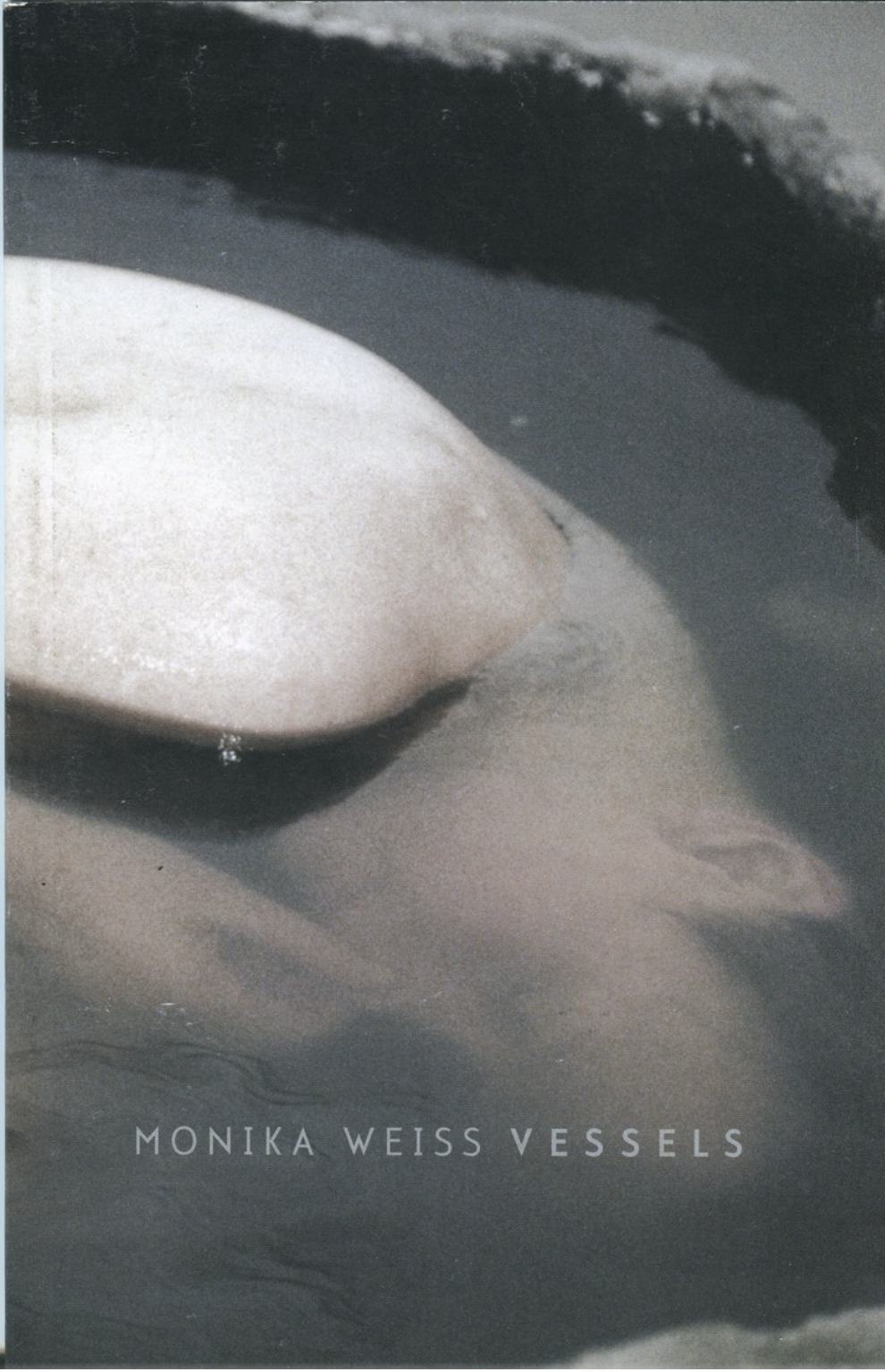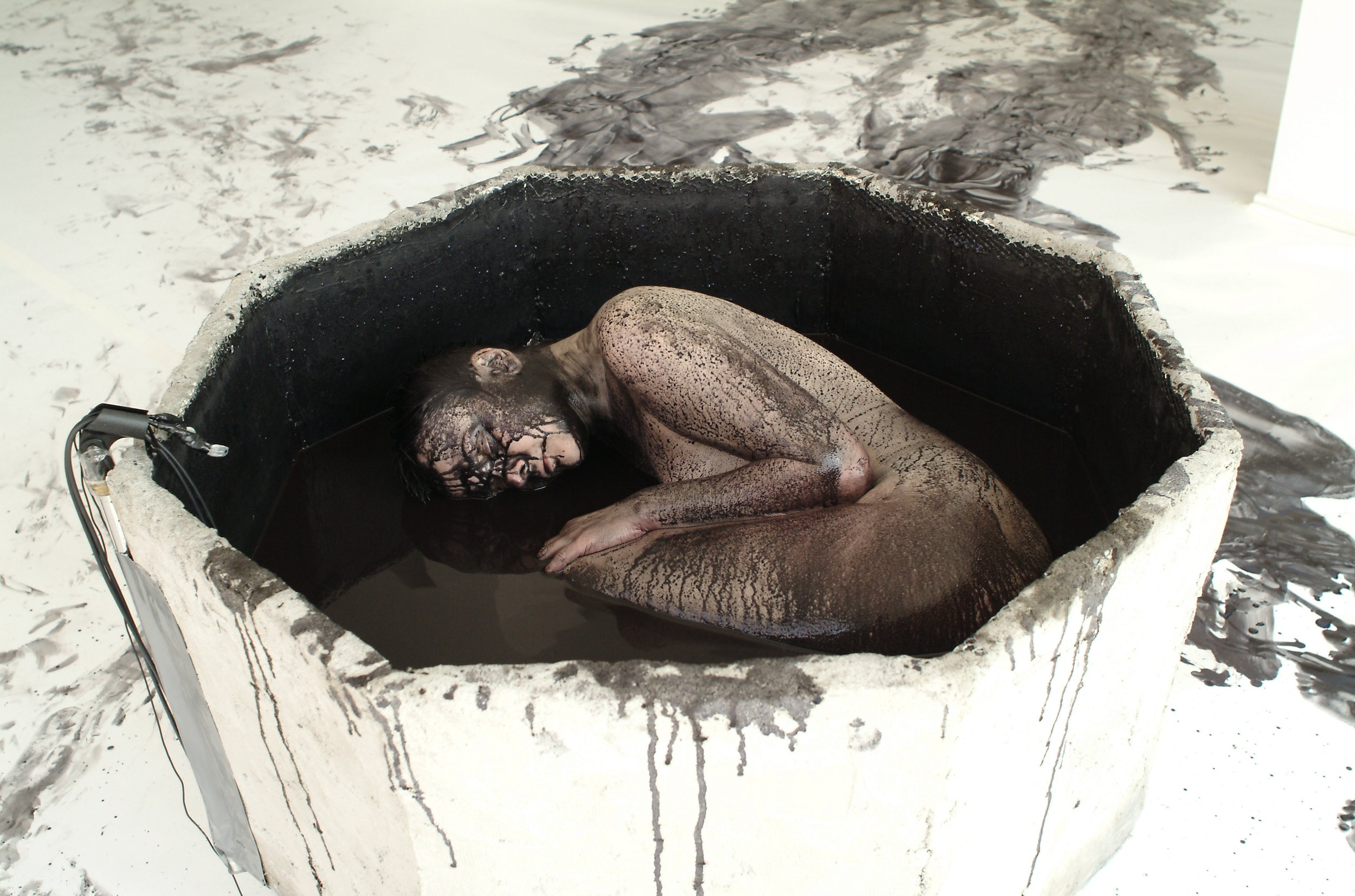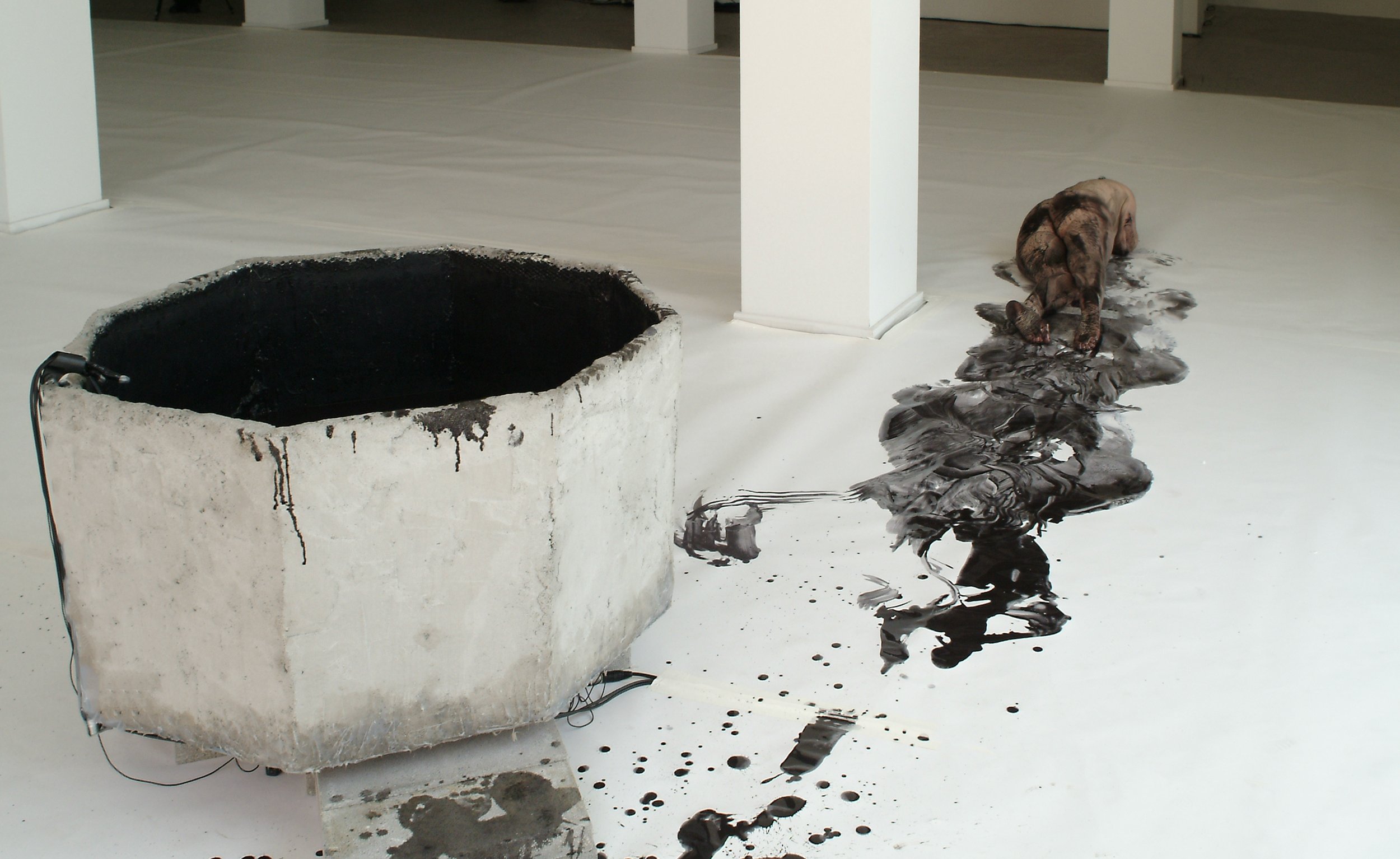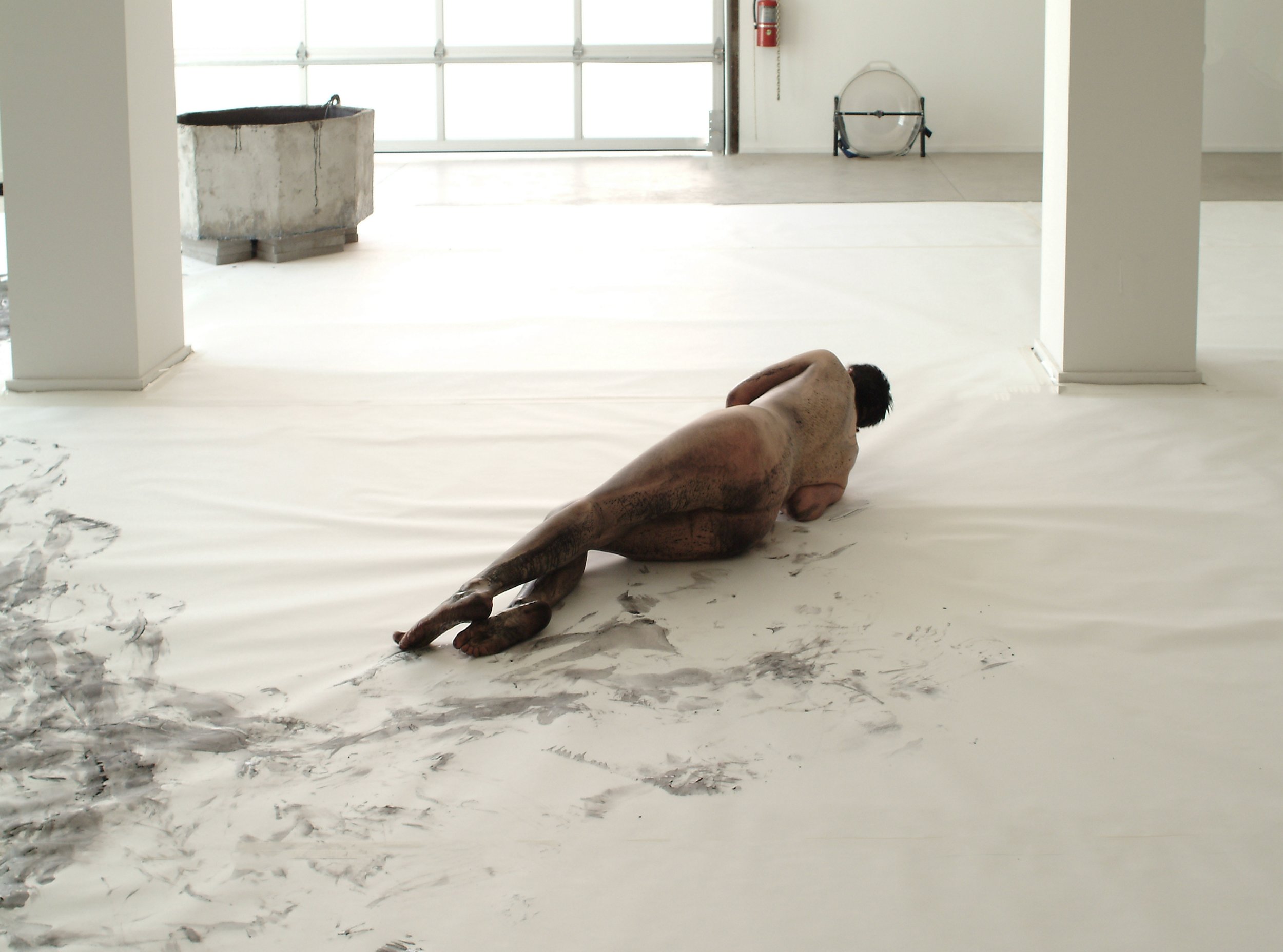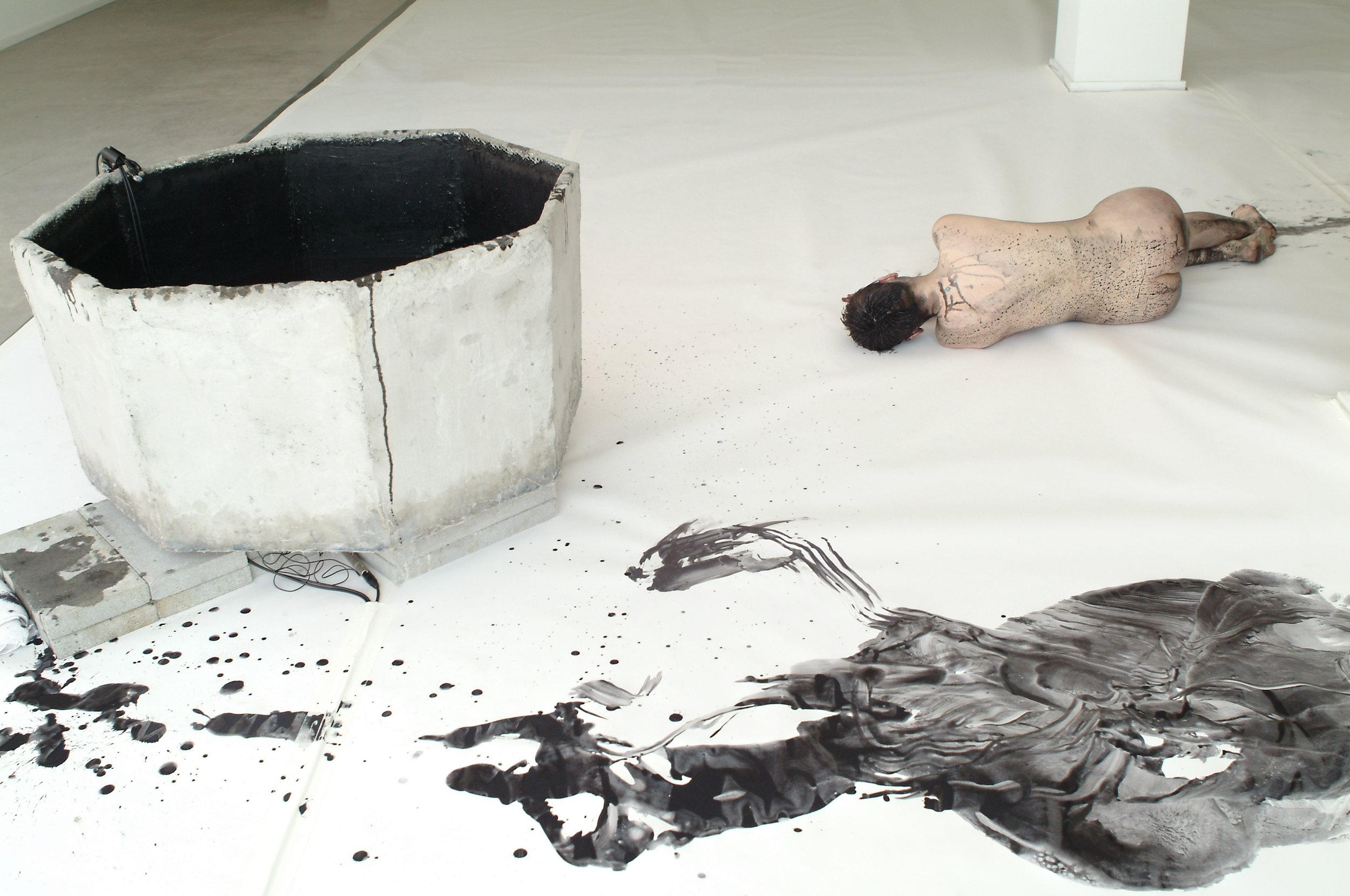George Quasha
Conceiving Body. Remarks on the side/Elytron (spirit and body are only two wings)
by George Quasha
in Monika Weiss-Vessels, Chelsea Art Museum, New York, 2004, pp. 7 -12
To treat the body as concept is to turn both body and concept into objects, things thrown before the mind. It happens often in art, sometimes intentionally. It happens in life, mostly unconsciously. In one of its extremes, the people who seem most “body centered” – people who commit seemingly heroic body acts (sports, for instance, like mountain climbing), especially the most challenging, even life-endangering acts, those that take “drive” to accomplish, and real endurance – in fact may be treating their bodies as things, tools, instruments. Some appear willing to “beat it into shape.” Others train the body like a wild animal, with uncompromising discipline, as if to civilize it, or perhaps redeem it (“Christianize” it) by snatching it out of the hands of the Devil, lest it be left to mere pleasuring ways. It can be a matter of morality, something like moralized flesh. The body as site of a massive struggle, a “war in heaven.” One might be tempted here to speak of degrees of incarnation, metaphorically of course, and risking popular clichés like “she’s not really in her body” – and yet, even clichés can have real meaning just as paranoids have enemies. Accordingly one might wonder how embodied the Olympian body really is – whether there’s anyone at home in those godlike constructs, or maybe we’re witnessing there a reverse Galatea phenomenon. (Perhaps deified athletes who mysteriously disappear have secretly been sold off to museums.)
A contrary possibility to treating the body as concept might be to treat the concept as body. This notion came to mind when I went to see Monika Weiss’ work Elytron at the Chelsea Art Museum in New York City; I was trying to understand how, despite the “stress and endurance” aspect, this work is not an instance of body as concept. (This, obviously, is not new in itself: we have instruction in depth for this performative questioning in the work of Marina Abramović, Mona Hatoum, Gary Hill, Carolee Schneemann, and others.) It can be straining, even painful to watch, as if the eyes take hold of the physical duress of a closely watched body. At first one looks intensively (the activity is after all nonstandard, if not bizarre), but the closer one gets to “staring” the more rigid the gaze and tensely “possessive” one’s own body posture; such is the nature of the stare and its physiological/ideological consequences. Inappropriate vigilance generates a sort of ocular over-reification – a perceptual “misplaced concreteness.” Perhaps one definition of truly performative art – art that (re)creates itself on the spot – is that it teaches us to gaze intensely without staring. It can change focus itself, the very capacity to focus.
The scenario “naked woman rises from tub” is transgression waiting to happen, and yet darkness intervenes in Elytron, her rising has a black lagoon effect, she is as much creature as woman. This is a personscape spreading out in time: she leaves the tub covered with the dark liquid and residue (a sort of reverse bath) and moves her body over the floor, around the room, and back to the tub, depositing as she goes. The piece is a species of time-management, and as such a reductio of the impulse to control time: a full five hours in all. It is also a species of space-disposal, confusing time and area, so that it takes on as much the status of time-lapse installation as it does performance. Perhaps few remain to see it through, but there is no “all” to a work like this; it is fully what it is at all points. The intense, almost laborious slowness of her moving body dilates even the most astonished gaze. The “object” ceases to be out there, and in a sense the “seen” is oneself, one’s seeing, the feeling or felt sensation, the fed-back registration of devolving body state under duress, which is the thing thrown before the mind, ob-jectified, ob-jected. The artist’s project is object as projection – a sort of self-engendered bodying forth.
There is a concept at work here, clearly. The piece, to be sure, is highly conceptual, as “endurance” art usually is. If there is indulgence, it’s not easily nameable, yet of course one may be tempted to speculate about what makes someone do this sort of thing. The concept is the first stop on the analytic agenda, but what is it? The title proposes: “Elytron” – “either of the leathery or chitinous forewings of a beetle or a related insect, serving to encase the thin, membranous hind wings used in flight.” Wing case. Sheath (Gk. elutron). Etymologically related to well, wallow, vault, volume, evolve, involve, volution, vulva, valve, valley, helix – meaning “to turn, roll” with derivatives referring to curved, enclosing objects. The mind is now free to involve itself, if not wallow, in the volutions of her valleys, her vault, her covering vulval well, and there to turn and roll in the curved enclosures until she wells up …. Alas, hit that valve, she’s becoming an object, albeit a verbal object. She needs to be recovered.
Recovery here is in her nakedness. We see all and nothing, yet sense a restoration through risk. All this obvious external action is highly involute, turning in and upon itself, yet tracked on the surface as it goes. She recovers outwardly, sharing her nakedness in marking the spot. Her encasement is most evidently the skin itself; she is enwrapped in herself brought to the surface – her surface, surface of the ground, their interface. Covered with black paint drawn from the dark well, she’s being baptized before our eyes as art instrument. Over and over. And the repetitive force is both ritual and conceptual, which go quite well together; ritual, after all, may be thought of as the earliest instance of proto-conceptual art.
Another part of the concept, carried by the subtitle, is taken from a nineteenth-century Polish poet, Zygmunt Krasinski: “spirit and body are only two wings.” So as we track her movements we are encouraged to see that we are only seeing half the action, the one wing as body itself. Staring won’t show us the other half. The gaze might as well subside, and move to the middle ground, to the space itself, to this gap in which we find the present action, the drawing out of the concept, the projection and bodily trajectory.
Built into this “conceptual body” is a critique of how we situate the body conceptually. Treating the body as object seems to be inevitable in our culture. Traditionally, for instance, Western anatomy is studied in the most objectified kind of body – the corpse. There is an underlying ambiguity in the very study of somatics, in that the word “soma,” which in the Greek context retained the problematic of life boundary, where the soma is also corpse, the threshold between living and dying. Soma as corpse becomes the model of science and medicine, so that the “living mind” is stuck with studying its body by cutting up an anonymous “discard” – the deserted remnant of its kind. As a result it reifies its condition as a machine-like collection of interchangeable parts and shifts attention away from the embodied whole. It ends up with brilliant tunnel vision. (Traditional Oriental Medicine offers a contrasting paradigm of an energetic whole, a resonant field in which every action is registered in the totality; many forms of recent Western alternative systems, particularly bodywork systems like Cranial Osteopathy or CranioSacral Therapy, use a similar paradigm.)
Further, to treat the body as object is to desubstantiate it, and, continuing over time, to dyssubstantiate it (make it ill). Can I speak of the body as it? Perhaps I violate it as I speak. The pronoun “it” fails to embody; “she” and “he” are too definite. The first trouble in speaking (of) the body is registered in the lack of a functionally accurate pronoun. Monika Weiss is engaged in a kind of concrete speech of the body – submerged in the dark pool/baptismal, or crossing the floor belly-first as a large, slow paintbrush…. (“Getting the paint across,” as Robert Ryman might say.) Yet this is a marginally gendered speaking, and she is only liminally a “woman seen” – naked, an art nude that might get away but that it’s caught in the medium, like a Gnostic spirit trapped in matter. Yet demiurge and creature/creation are one and the same here: she is never fully on the loose. Painter, painted, and painting are one, with only a trace, a trail, a track. The remnant appears to be on the edge of becoming a giant historical doodle, something we might fear that we and our art could end up as -- a necessary but inconsequential jotting on the terrain. A revenant haunting the site of meaning.
What motivates such frictively “moving” inscription that can’t help removing a measure of flesh with its black marking? Photos of body and floorpaper show a dark message in abstraction that also attracts with an abrasive beauty, as if despite the confinement in self-infliction something strikes out on its own behalf, something alive gets free. As a man I can’t help seeing it as a power of her body, re-gendering, engendering a way out of this mess. It is messy. Each sharpness of mark quickly blurs, an impermanence of every moment that competes for identity. Nothing remains very long in this journey, this rite of crossing the floor. The body makes a sort of image and then mops it.
Each creative gesture is the source of its own extinction. Motivation is being impelled to do the next thing. What keeps it going? The question comes up here as it does with Beckett’s Molloy, the driven self-conscious locomotion inch by inch; can’t go on/will go on. The rhetoric of endurance without the development of identity, story, drama. Just a person, stripped down – literally, to the skin and beyond, on the verge of being skinned.
Motivation – getting out of one’s water – becomes a slow oscillation between submergence and emergence; skin as barrier against cold and as contact with surface; water and earth. She as we, always still sea-creaturing, “leaping between two worlds/unable to bear either.” Extremes become indistinguishable, or contraries are linked by their intensity. Existential angst or ontological anxiety cannot tell itself from art perplexity or spiritual confusion. Rapture? Ecstasy? The body is beside itself with unmanageable energy, in search of its mystery; intensified wearing down as vision quest. On the lam from life in its objecthood; on the way out of the dark and oily baptismal. Transubstantiation through bodily transport up and over the edge and onto the floor. Bruising art. Visionary voyeurism with cataracts. Flapping one’s epidermal scales for the optimal lift.
At issue here in this degree of art ambivalence is the vary nature/function of image and body, a matter rooted in life itself as how we show up in the eyes of others, show ourselves and get the feedback, see our/the body through its imaging, the image that stands between us and the world. So standing in this intrinsic liminality of seeing the world through one’s own eyes and oneself through the world’s eyes (“autopsy,” literally and finally, as Stan Brakhage insisted), we come upon the historical moment through mediating powers; the art angle in its grasp of reality, where “valence” at root is “power, strength,” hence the doubling (ambi) of two-handed nuance that both divides and surrounds. Embracing strength/wavering potency.
The vary participation in the play of powers between world and self is an imaging, which Monika Weiss literalizes through the medium of tracking body and its inky tracing. At the same time she engages the body’s tentative projectivity as a further imaging, here accomplished through a video god’s-eye view of the octagonal tub. In this performance/installation we see, as we first enter the room, her embryo-like submerged body projected live on a far wall which we approach. It has a ghostly quality, like new memory of distant conception, something still happening in the residue of emerging struggle to be. Barely gendered; gender at the margin of itself; hope of engendering. Which might suggest a politics of choice with respect to “side” of the gender “line” – a free discrimination of being always already on this side, yet subject to change as a dynamic of relation. Sex as choice itself in the doubling valence of social being. The video (“I see”) becomes the opportunity of overview and intraview of any position, and the possibility of reflective dislocation that relocates.
Monika Weiss’ way of operating at the edge is to expose her boundary, her envelope, that is, her skin, to continuous radical feedback and performative definition. Her “artistic” decisions – like those of, in my mind, the major sources of this specific “kind” of “endurance” art in our time – find their center less in a recognizable aesthetic than in an individuated politics, an ontologic, perhaps something like a theogenics. (Could such art be a very slow-acting entheogen?) But to say this is to further destabilize definition – toward preserving us from belief in what we see. Visualart moves easily toward conceptualized body. This art may be, among other things, a way around the hardening boundary of belief, toward conceiving body – body remaking itself, us, in its threshold nature, its/our liminality. We say the body conceives to make more of its kind; so there must be art that performs this principled conception, a test of which is whether it brings one to an edge that opens further.
George Quasha, New York, 2003
George Quasha
Poet, writer, musician, and artist George Quasha was born in White Plains, New York, and grew up in Florida. His many full collections of poetry include Amanita’s Hymnal (1970), Magic Spell for the Far Journey (1971), Somapoetics (1973), Word-Yum: Somapoetics 64-69 (1974), Giving the Lily Back Her Hands (1979), Ainu Dreams (with Chie Hasegawa, 1999), and preverbs, Verbal Paradise (2011). Quasha’s projects include “art is,” recordings of more than 800 artists, poets, and composers (including Monika Weiss) discussing their understanding of art. Quasha continues to work on a 30-year performance collaboration (video/language/sound) with artists Gary Hill and Charles Stein. Quasha’s honors and awards include fellowships from the National Endowment for the Arts and the Guggenheim Foundation.
